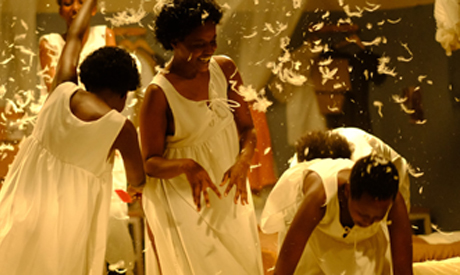Sometimes the components of a film may be of a good quality – perfect editing, beautiful costumes, astonishing cinematography, touching score, outstanding acting – when a shallow point of view or a predictable development spoils the whole piece. In a post-screening discussion of one such film, the well-known Egyptian filmmaker Youssry Nassrallah said, “Storytelling is no easy task.” He seemed to encapsulate the very notion of cinema. Whether making a documentary or a narrative feature, a filmmaker can fuss as much as they like with the other ingredients, which are admittedly of equal importance, but without the substance of the recipe – storytelling – the dish won’t turn out right.
A significant film that might fall under this category was the Algerian film Papicha directed by Mounia Meddour which participated in the Feature Narrative Competition of the El Gouna Film Festival (GFF) and itwon the El Gouna Star for Best Arab Narrative. The script depicts the rise of the Islamic fundamentalism in Algerian society during decade-long civil war between the army and Islamic extremists. Focusing on students at the girls’ dorms in the 1990s, it recalls Bob Fosse’s 1972 Cabaret, in which the love story develops in the 1930s during the collapse of the Weimar Republic and the rise of the Nazi Party in Berlin, and the structure of which inspired Meddour.
The main character in Papicha is Nedjma, who though both pretty and talented in costume design must contend with people who want to impose seventh-century sartorial norms by way of returning to the beginnings of Islam and fighting Westernisation. They even murder her sister, an anti-Islamist journalist. The film shows the challenges the young woman faces with her friends and roommates through her attempt to organise a fashion show on campus, the first move on the way to her dream career and a gesture of resistance, even a kind of retaliation for her sister’s murder, leading to the climactic master scene in which the dorms are brutishly stormed.
But, rather than filling out the main storyline, as it were, by including too many subplots the filmmaker ends up telling a loose, repetitive and sometimes banal story, with characters like Nadjma’s colleague Samira, who wears the hijab, ending up pregnant out of wedlock. The intention may be to highlight the contradiction between modern female needs and Islamic fundamentalism, but the result is an abortive dramatic line which, by the time large-scale Islamic violence erupts – Meddour’s abrupt way of ending the film – is still unresolved. Papicha could have been a powerful film had the story not slipped into ordinary tragedy, its point unpleasantly belaboured.
***

The Weeping Woman
Another feature narrative competition film about 20th-century atrocities Jayro Bustamante’s The Weeping Woman – about the mass killings of the indigenous population in Guatemala. In portraying the protagonist, the chief of staff of the Guatemalan Army Enrique Monteverde, Bustamante is influenced by the trail of the Guatemalan dictator Efraín Ríos Montt, an army officer who helped to stage the 1982 coup d’etat, when he became president. He was implicated in the genocide of the Mayan population, for which he was convicted in 2013, though due to age and failing health he was never sentenced.
But The Weeping Woman is about neither genocide nor trial. It is about the daily, family life of General Monteverde. Working in the horror genre as well as straightforward drama, the script mixes the realistic story of a mass murderer with the Latin American legend of the Llorona, the crying woman, a young mother abandoned by her husband and driven by grief to drown her two children in the river and kill herself. Her punishment is to keep finding her children’s corpses wherever she goes for all eternity. Monteverde is tormented by the sound of a crying woman, so much so that, trailing the sound one night with his pistol, he nearly kills his wife. The action develops before the trial during the Mayans’ protests outside Monteverde’s house, where one of the house maids is a strangely silent Mayan who seems to be a actual avatar of Llorona. This is a new, not entirely successful departure for Bustamante since he won the Alfred Bauer Award for his debut Ixcanul in the 2015 Berlinale.
***

Our Lady of the Nile
Also screened in the feature narrative competition was Our Lady of the Nile by French-Afghani filmmaker Atiq Rahimi, whose debut, Earth and Ashes, won the Regard Original Award at Cannes in 2004. Based on a novel by the Paris-based Rwandan author Scholastique Mukasonga, the film is set in a Belgian Catholic school for girls in 1973, and it depicts the roots of tribal and class division that led to the civil war and the genocide in Rwanda in the 1990s.
Our Lady of the Nile opens with daily life inside the school and the dorms where the girls share work and fun. With the actors wearing the same uniform and haircut, physical differences that set the Hutu and Tutsi apart are not apparent to the audience, though in some sense the script presupposes knowledge of the difference and conflict between the two tribes. Racism is only hinted at at first, largely through the daughter of a minister in the Rwandan government who becomes the leader of the Hutu majority, while a Tutsi girl is bullied by being told that her people are known as the cockroaches. It is a Tutsi girl who is the only survivor of an attack by armed men killing everyone, Hutus and Tutsis and Belgians. She hides under dirty clothes in the laundry room and manages to kill he would-be rapist. The film was a very enjoyable experience from a cinematic point of view, with excellent acting from non-professionals and stunning cinematography, but as a story you can make sense of in context it leaves much to be desired.
*A version of this article appears in print in the 10 October, 2019 edition of Al-Ahram Weekly.
Short link: